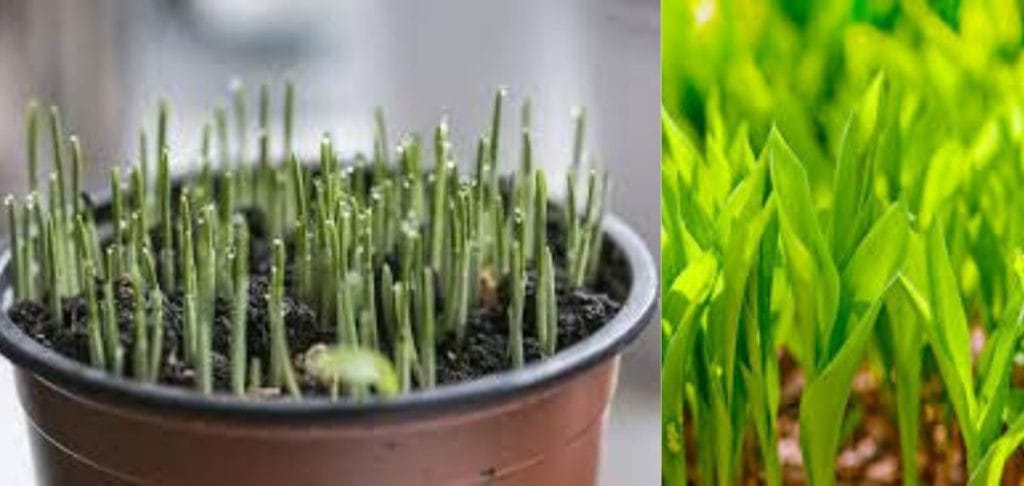Grass is an essential part of a beautiful garden, & there’s nothing quite like the lush green carpet that a healthy lawn provides. It is important to learn on “best garden shears”. If you’re looking to grow grass from seeds, you might be wondering how long it will take before you can enjoy the fruits of your labor. The truth is that there is no one-size-fits-all answer to this question, as the amount of time it takes for grass to grow from seeds depends on several factors. Growing a lush green lawn from grass seeds is a rewarding experience that requires patience & dedication.
Many factors come into play when determining how long it takes for grass seeds to grow, such as the type of grass, soil conditions, watering, & climate. However, one crucial element that often gets overlooked is timing. Planting grass seeds at the right time can make all the difference in the success of your lawn. In this article, we will explore the best time to plant grass seeds & “best garden shears” & we’ll explore the variables that affect grass growth & provide some tips on how to speed up the process. We are best lucky for “best garden shears”

Table of Contents
cutting edge: “best garden shears” of 2024
Grass Type
The first factor that affects how long it takes for grass to grow from seeds is the type of grass you’re planting. Different species of grass have different growth rates, with some taking longer than others to establish. For example, Bermuda grass can germinate in as little as five days, while Kentucky bluegrass can take up to 21 days to germinate. We have try to understand on “best garden shears”.
Soil Quality
The quality of the soil in which you plant your grass seeds can also affect how long it takes for them to grow. Soil that is rich in nutrients & has a balanced pH level will provide an optimal environment for grass growth. On the other hand, poor-quality soil can slow down the growth process or even prevent the seeds from germinating altogether.
Watering
Watering is another crucial factor in grass growth. When you plant grass seeds, it’s important to keep the soil moist but not waterlogged. Overwatering can drown the seeds, while underwatering can prevent them from germinating. Additionally, the frequency & amount of water you provide will depend on the climate & the type of soil in which you’re planting.
Temperature & Weather Conditions
The temperature & weather conditions in your area can also affect how long it takes for grass to grow from seeds. Grass seeds generally germinate best in temperatures between 60 & 75 degrees Fahrenheit. If the temperature is too hot or too cold, it can slow down the growth process. Additionally, if there is a lack of sunlight or too much rain, it can also impact the growth of the grass. We can understand on “best garden shears”.
Now that we’ve discussed the factors that affect grass growth let’s dive into some tips on how to speed up the process:
Prepare the Soil
Before you plant your grass seeds, it’s essential to prepare the soil properly. Other beads, rocks, & other debris should be removed from the area where you plan to plant. Then, loosen the soil with a rake or tiller, so the roots of the grass seeds can penetrate the soil more easily. Finally, add a layer of topsoil or compost to provide the grass with the nutrients it needs to grow. best gardening best life for “best garden shears”.
Choose the Right Grass Type
As we discussed earlier, different species of grass have different growth rates. If you’re looking for a fast-growing grass type, consider Bermuda grass or ryegrass. If you’re looking for a low-maintenance option, consider Zoysia grass or fescue. Be sure to do your research & choose the right grass type for your climate & soil conditions.
Water Consistently
Consistent watering is crucial to the growth of grass from seeds. Water the soil lightly but frequently, so it stays moist without becoming waterlogged. If you live in an area with little rainfall, consider using a sprinkler system or a drip irrigation system to ensure your grass receives enough water. We should know about “best garden shears”
Fertilize Regularly
Fertilizing your grass regularly will provide it with the nutrients it needs to grow quickly & healthily. Choose a high-quality fertilizer that is appropriate for the type of grass you’re growing & follow the instructions carefully.
The Best Time to Plant Grass Seeds
The timing for planting grass seeds depends on the type of grass & the climate in your region. In general, the best time to plant grass seeds is in the early fall or spring. This is when the soil temperature is between 50 & 65 degrees Fahrenheit, & there is enough moisture in the soil to allow for germination. Planting during this time also gives the grass a chance to establish strong roots before the heat of summer or the cold of winter sets in. “Best Garden Shears” is the topic head.
If you live in a region with a mild climate, such as the Pacific Northwest, you can plant grass seeds in the fall or spring. However, if you live in a region with extreme temperatures, such as the South or Midwest, it is best to plant in the fall. This will give the grass enough time to establish before the heat of summer sets in, which can be detrimental to the growth of grass. “Best garden shears” will understand.
Factors affecting germination time
- Water availability affects germination time, with seeds requiring sufficient moisture but excess water leading to rotting.
- Optimal temperatures for germination vary among different plant species, with most preferring warm temperatures between 20-30°C.
- Oxygen is necessary for germination, with some seeds requiring more than others.
- Light can play a role in germination, with some seeds requiring light to trigger the process.
- Understanding these factors can help gardeners & farmers optimize conditions for successful seed germination. The topic “best garden shears” needs to be known in detail.
Typical germination timeline
- The typical germination timeline varies among different plant species.
- Some seeds may germinate in just a few days, while others may take weeks or even months.
- The germination process usually begins with water absorption & ends with the emergence of the radicle or embryonic root.
- Temperature, water availability, & oxygen levels can all affect the speed of germination.
- Some plants may require stratification, or exposure to cold temperatures, to break dormancy & begin the germination process.
- Understanding the typical germination timeline for specific plants can help gardeners & farmers plan for planting & harvesting, & optimize growing conditions for successful growth. Need to know what the “best garden shears” thing is.
First signs of growth
The first signs of growth in a seed typically include the emergence of the radicle or embryonic root. This is often followed by the emergence of the shoot & the appearance of the first leaves. These early stages of growth are critical for establishing a strong & healthy plant. The timing of these early stages can vary depending on the plant species & environmental conditions, such as temperature, water availability, & light exposure. Monitoring the first signs of growth can help gardeners & farmers ensure that their plants are growing properly & identify any issues early on, such as damping off or nutrient deficiencies.
Growth stages
Garden seeds go through several growth stages before reaching maturity. After germination, the seedling stage begins, where the plant develops its first true leaves & begins to photosynthesize. The vegetative stage follows, where the plant continues to grow & produce new leaves & stems. Once the plant has matured enough, it will enter the reproductive stage & produce flowers or fruit. Finally, the plant reaches maturity & enters the senescence stage, where it begins to decline in health & productivity. Understanding these growth stages is important for gardeners & farmers to plan for planting, pruning, & harvesting, & to ensure that their plants are growing properly & producing healthy yields. “Best Garden Shears” is good to know.
Tips for optimizing growth time
- Choose high-quality seeds from reputable sources.
- Ensure that the soil is properly prepared with adequate nutrients, water, & drainage.
- Monitor & adjust environmental conditions such as temperature, humidity, & light exposure.
- Avoid overcrowding & provide adequate spacing for plants to grow & receive sunlight.
- Regularly remove weeds & pests that can compete for resources & damage plants.
- Use fertilizers & other amendments as needed to promote healthy growth.
- Prune & train plants to promote optimal growth & shape. “Best Garden Shears” Gardening will not be easy for gardeners without knowing it.
- Harvest at the appropriate time to maximize yields & avoid over-ripening or spoiling.
- Regularly assess & adjust growing methods based on plant health & performance. “Best Garden Shears” is good to know.
What is the typical germination time for grass seeds to sprout & grow?
The time it takes for grass seeds to grow varies depending on the type of grass, soil conditions, & weather. In general, it takes between 7 & 30 days for grass seeds to germinate. However, it can take up to 6 weeks for the grass to establish a strong root system & start growing vigorously. “Best Garden Shears” Why Gardeners Need to Know?
Factors That Affect Grass Seed Growth
Several factors can affect the growth of grass seeds. These include:
- Soil temperature: As mentioned earlier, the soil temperature should be between 50 & 65 degrees Fahrenheit for grass seeds to germinate. If the soil temperature is too low, the seeds may not germinate, & if it’s too high, the seeds may dry out.
- Soil moisture: Grass seeds need moisture to germinate & grow. If the soil is too dry, the seeds will not germinate, & if it’s too wet, the seeds may rot.
- Sunlight: Grass seeds need sunlight to grow. If the soil is too shaded, the seeds may not germinate or grow properly.
- Soil quality: The quality of the soil can also affect the growth of grass seeds. Soil that is too compacted or has too much sand or clay can hinder seed growth. The “best garden shears” topic needs to be known now.

Tips & Tricks for success
Having a lush, green grass is a source of pride for many homeowners. However, maintaining a beautiful green grass requires some effort & attention to detail. Here are some seed grass-care tips for success:
- Keep the soil moist but don’t over-water: Water your lawn regularly to keep the soil moist, but avoid over-watering as this can cause root rot & other issues.
- Sow seed in spring or autumn: The best time to sow grass seed is in the spring or autumn when the soil temperature is at least 8°C. This will give the seed the best chance to germinate & grow.
- Don’t let the soil dry out: Until you see a dense mat of green growth where you sowed the seed, make sure the soil does not dry out. This is crucial for the success of your lawn.
- Use a high-quality seed mix: Choose a high-quality seed mix & follow the instructions on the packet for the best results. Be sure to sow the seed at the recommended density.
- Avoid sowing on a windy day: Wind can blow grass seed about, making it difficult to achieve even coverage. Choose a calm day to sow your grass seed. “Best Garden Shears” is very useful in gardening.
Following these tips will help you maintain a healthy grass that will be the envy of your neighbors. With a little effort & patience, you can achieve the green grass field of your dreams.
How to grow a lawn from seed?
Growing a lawn from seed is a rewarding process that requires patience & attention to detail. Here are some tips to help you achieve a lush, healthy lawn from seed.
First, prepare the soil by removing any debris, rocks, or weeds. Loosen the soil with a garden rake, & then level it out using a lawn roller. Add a thin layer of compost or topsoil to improve soil quality.
Next, choose a high-quality grass seed that is appropriate for your region & the amount of sun exposure your lawn will receive. Read the instructions on the seed package carefully to determine the recommended seeding rate.
Spread the seed evenly over the soil using a seed spreader. Cover the seeds with a thin layer of soil & rake the soil lightly. Water the soil immediately after seeding, & then water it regularly to keep it moist until the grass is established.
Be patient, as it can take several weeks for the grass to germinate & establish. During this time, avoid walking on the lawn & keep pets off of it to prevent damage to the delicate new growth.
Once the grass has established itself, begin mowing it regularly, keeping the blades at a height of around 2-3 inches. Fertilize the lawn periodically to promote healthy growth.
By following these tips, you can grow a beautiful lawn from seed that will be the envy of your neighborhood.
How to repair a lawn patch?
Having a lush & healthy lawn is the dream of every homeowner, but sometimes a patchy lawn can be a real eyesore. Fortunately, repairing a lawn patch is not as difficult as it may seem. Here are some steps to help you get your lawn back to looking its best.
Prepare the soil: Remove any dead grass or debris from the patch & loosen the soil with a rake.
Add grass seed: Spread grass seed over the patch, following the recommended seeding rate on the seed bag. Cover with soil: Cover the seeds with a thin layer of soil or peat moss to help retain moisture.
Water regularly: Keep the soil moist by watering it regularly, but be careful not to overwater.
Fertilize: Apply a balanced fertilizer to the patch once the grass begins to grow.
Mow regularly: Once the grass reaches a height of 3-4 inches, mow it down to encourage growth & keep it looking neat.
With a little patience & care, your lawn patch will soon be a distant memory, & your lawn will be back to looking its best in no time.
Conclusion
Growing grass from seeds is a process that requires patience & attention to detail. Timing is an essential element that can determine the success of your lawn. Planting grass seeds at the right time, when the soil is warm & moist, can help ensure a healthy & vibrant lawn. It takes between 7 & 30 days for grass seeds to germinate, but it can take up to 6 weeks for the grass to establish a strong root system & start growing vigorously. By considering the factors that affect grass seed growth, such as soil temperature, moisture, sunlight, & soil quality, you can help ensure the success of your lawn.
Read our another article




